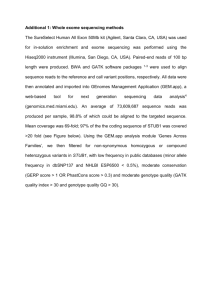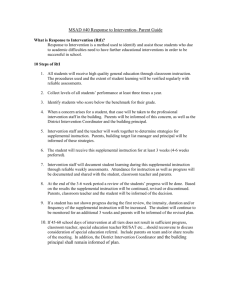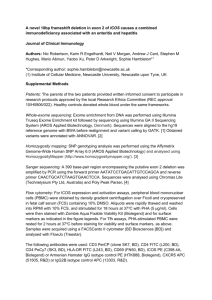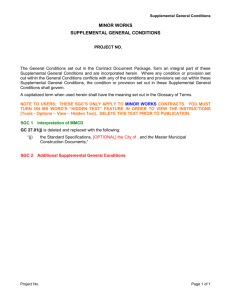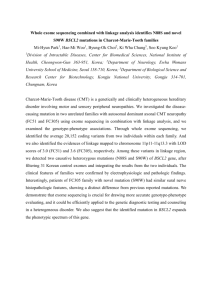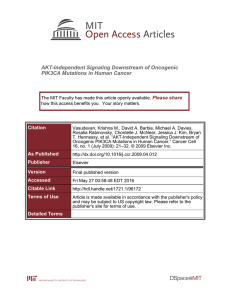Supplemental Methods and Supplemental Figure Legends M
advertisement
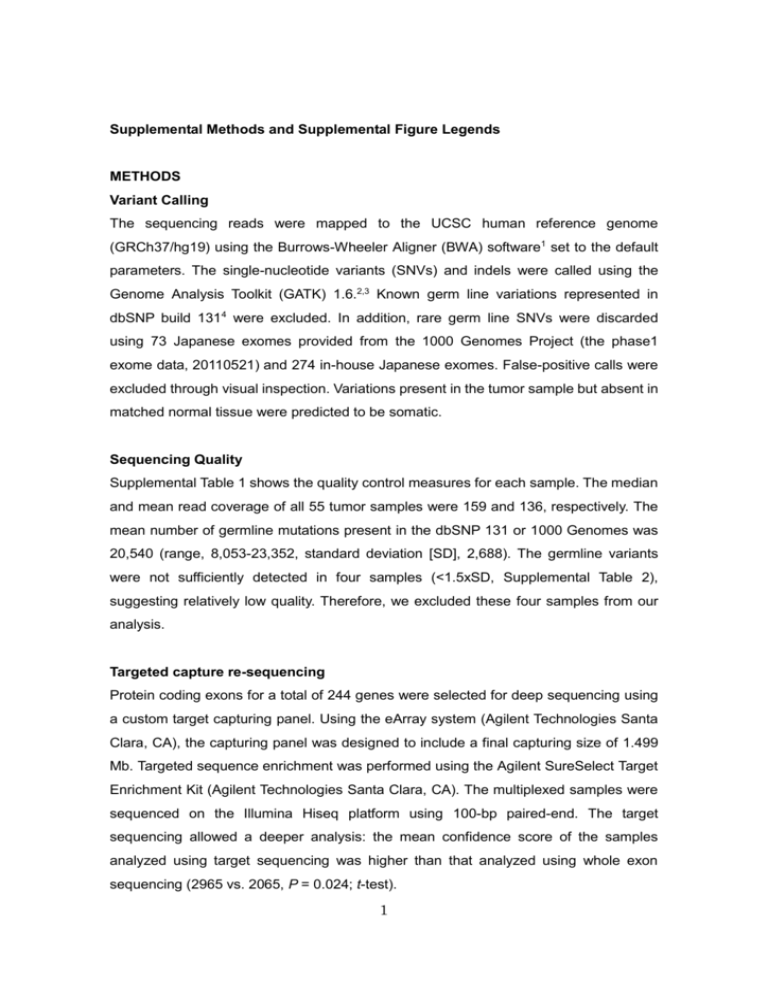
Supplemental Methods and Supplemental Figure Legends METHODS Variant Calling The sequencing reads were mapped to the UCSC human reference genome (GRCh37/hg19) using the Burrows-Wheeler Aligner (BWA) software1 set to the default parameters. The single-nucleotide variants (SNVs) and indels were called using the Genome Analysis Toolkit (GATK) 1.6.2,3 Known germ line variations represented in dbSNP build 1314 were excluded. In addition, rare germ line SNVs were discarded using 73 Japanese exomes provided from the 1000 Genomes Project (the phase1 exome data, 20110521) and 274 in-house Japanese exomes. False-positive calls were excluded through visual inspection. Variations present in the tumor sample but absent in matched normal tissue were predicted to be somatic. Sequencing Quality Supplemental Table 1 shows the quality control measures for each sample. The median and mean read coverage of all 55 tumor samples were 159 and 136, respectively. The mean number of germline mutations present in the dbSNP 131 or 1000 Genomes was 20,540 (range, 8,053-23,352, standard deviation [SD], 2,688). The germline variants were not sufficiently detected in four samples (<1.5xSD, Supplemental Table 2), suggesting relatively low quality. Therefore, we excluded these four samples from our analysis. Targeted capture re-sequencing Protein coding exons for a total of 244 genes were selected for deep sequencing using a custom target capturing panel. Using the eArray system (Agilent Technologies Santa Clara, CA), the capturing panel was designed to include a final capturing size of 1.499 Mb. Targeted sequence enrichment was performed using the Agilent SureSelect Target Enrichment Kit (Agilent Technologies Santa Clara, CA). The multiplexed samples were sequenced on the Illumina Hiseq platform using 100-bp paired-end. The target sequencing allowed a deeper analysis: the mean confidence score of the samples analyzed using target sequencing was higher than that analyzed using whole exon sequencing (2965 vs. 2065, P = 0.024; t-test). 1 Sanger Sequencing PCR primers were designed using Primer3 plus software (http://www.bioinformatics.nl/primer3plus/). The primer sequences are listed in Supplementary Table 8. PCR was performed using the HotStarTaq PCR kit (Qiagen, Hilden, Germany). The sequencing products were resolved using an ABI 3500 genome analyzer (Life Technologies, Carlsbad, CA), and chromatograms were analyzed using sequencing analysis software version 5.4 (Life Technologies, Carlsbad, CA). Exome Sequencing of the Other Japanese Cohort (Supplemental Table 6) The TruSeq DNA Sample Prep kit was used to prepare the DNA, and the Illumina TruSeq Sample Prep Kit was used to construct the library. Exome enrichment was performed using the Illumina TruSeq Exome Enrichment Kit. Exome capture libraries were sequenced using the Illumina GAIIx to generate 100-bp paired-end data. Purchased Materials The human SCLC cell lines NCI-H82 (ATCC#HTB-175), NCI-H209 (ATCC#HTB-172), NCI-H446 (ATCC#HTB-171), NCI-H1048 (ATCC#CRL-5853), and NCI-H1694 (ATCC#CRL-5888) and fetal bovine serum (FBS) were obtained from ATCC (Manassas, VA). BEZ235, BKM120, INK128, and MK2206 were purchased from Selleck (Houston, TX) and were dissolved in dimethyl sulfoxide (Wako, Japan). Phospho-AKT (Ser473), pan-AKT, GAPDH, p-S6RP (Ser235/236) (CST#4858), S6RP (CST#2217), and PIK3CA (CST#4249) antibodies were obtained from Cell Signaling Technology (CST, Danvers, MA). ECL anti-rabbit IgG HRP-linked whole antibody, ECL Western Blotting Detection reagent, and X-ray films were purchased from GE Healthcare (Pittsburgh, PA). WST-8 Assay Cell lines were cultured in RPMI-1640 supplemented with 10% fetal bovine serum (FBS) or HITES medium with 5% FBS. Ten thousand cells were plated in replicates of three into 96-well plates. After 72 hours of incubation with inhibitors, the cell viability was analyzed using the Cell Counting Kit-8 (Dojindo, Kumamoto, Japan). Western Blotting (WB) 2 Cells were lysed in RIPA buffer on ice for 10 min and centrifuged at 15,000 ×g for 10 min. The protein content of the supernatants was quantified using a BCA assay (Pierce, Rockford, IL). The same amounts of protein samples were separated using a SDS/PAGE and were transferred to a PVDF, then incubated overnight with primary antibodies (1:1,000). The primary antibodies were p-AKT (Ser473) (CST#4060), AKT (CST#4685), and GAPDH (CST#2118). ECL anti-rabbit IgG HRP-linked whole antibody (GE Healthcare, 1:10,000) was used as a secondary antibody. Signals were detected using ECL Western Blotting Detection reagent (GE Healthcare) and X-ray films (GE Healthcare). siRNA targeting PIK3CA NCI-H1048 cells (1.0 × 105) were transfected with 5 nM siPIK3CA#1 (s10520; Life Technologies, Tokyo, Japan), siPIK3CA#2 (s10521; Life Technologies, Tokyo, Japan), siPIK3CA#3 (s10521; Life Technologies, Tokyo, Japan) or siNC (4390843; Life Technologies, Tokyo, Japan) using Lipofectamine RNAiMAX Reagent (Life Technologies, Tokyo, Japan). After 72 hours of incubation with siPIK3CA, the cell viability was analyzed using the Cell Counting Kit-8 (Dojindo, Kumamoto, Japan). The total RNA and protein samples from the H1048 cells were prepared after 72 hours post-transfection. Quantitative RT-PCR RNA from H1048 cells was isolated using TRIzol Reagent (Invitrogen) and complementary DNA (cDNA) was synthesized using the SuperScript VILO cDNA synthesis kit (Life Technologies, Carlsbad, CA). Synthesized oligonucleotides for PIK3CA (HA217828) were purchased from TaKaRa Bio (Shiga, Japan). Real-time RT-PCR was performed using specific primers and a 7500 detection system (Life Technologies, Carlsbad, CA). The relative quantitation value of PIK3CA, as compared with that for β-actin, was expressed as 2−(Ct–Cc). 3 Supplemental Figure Legends Supplemental Figure 1 Overview of the copy number analysis Supplemental Figure 2 A) A histogram of the number of protein-altering mutations in each primary sample. Number of mutations*: number of protein altering mutations (SNV+INDEL). B) The average frequency of transitions and transversions in the SCLC samples based on the exome sequencing data. Supplemental Figure 3 Schematic representation of the somatic mutations found in the PI3K/AKT/mTOR pathway genes. The horizontal bar represents the full-length protein, and functional domains are shown as boxes. The somatic mutations found in the SCLC samples are marked according to their Polyphen scores or mutation types: red text=damaging missense mutation, nonsense mutation, or INDEL; black text=benign missense mutation. Supplemental Figure 4 Validation of Sanger sequencing. Vf: variant allele frequency Supplemental Figure 5 Analysis of broad copy number alterations by GISTIC version 2.0 Copy number analysis of the 47 human SCLC samples using our rank-sum based algorithm. Here, the thresholds are adjusted to extract the broad copy number events. A) Amplification q values plot B) Deletion q values plot Supplemental Figure 6 Mutation patterns of the PI3K/AKT/mTOR pathway, MAPK/ERK pathway, and Receptor tyrosine kinases in 47 SCLC samples Each column represents an affected individual, and each row represents a gene. 4 The number of events per gene is noted on the left. M: mutation, CN: copy number gain (copy number, ≥4), or loss (copy number, 0) Supplemental Figure 7 The dose-response cell survival curves of SCLC cell lines with or without genetic alteration in the PI3K/AKT/mTOR pathway in response to (A) INK128 (nM), (B) MK2206 (nM), and (C) BKM120 (nM) Supplemental Figure 8 The silencing of PIK3CA affected cell viability and the activation of PI3K/AKT/mTOR downstream signaling. H1048 cells were transiently transfected with three siRNA constructs targeting PIK3CA (siPIK3CA: #1, #2 and #3) or a non-targeting control (siNC). PIK3CA was effectively silenced using siRNA. A) Relative quantitation value of PIK3CA mRNA, as compared with β-actin. B) Western blotting with antibodies for the proteins in the PI3K/AKT/mTOR signaling cascade. C) Cell viability of H1048 cells transiently transfected with siPIK3CA or siNC. REFERENCES FOR SUPPLEMENTAL METHODS 1. Li H, Durbin R. Fast and accurate short read alignment with Burrows-Wheeler transform. Bioinformatics 25: 1754-1760, 2009. 2. McKenna A, Hanna M, Banks E. et al. The Genome Analysis Toolkit: a MapReduce framework for analyzing next-generation DNA sequencing data. Genome Res 20: 1297-1303, 2010. 3. DePristo MA, Banks E, Poplin R. et al. A framework for variation discovery and genotyping using next-generation DNA sequencing data. Nat Genet 43: 491-498, 2011. 4. Sherry ST, Ward MH, Kholodov M et al. dbSNP: the NCBI database of genetic variation. Nucleic Acids Res 29: 308-311, 2001. 5
